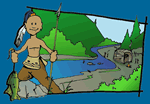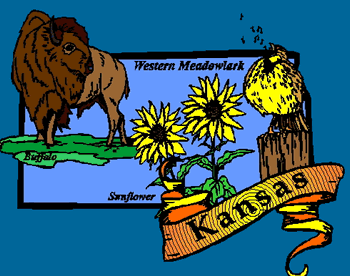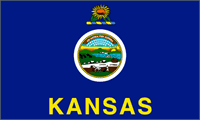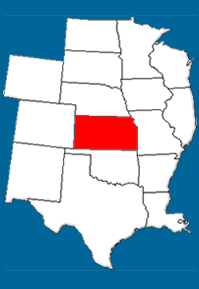 First Inhabitants:
Archaeologists tell us that people have been living in the area now known as Kansas since 12,000 BC, during the end of the Ice Age. Huge animals such as mammoth and mastodon lived in the area until climate change made it too warm for them to survive. It is believed that the first people who migrated to Kansas were descendents of people from Asia who crossed into North America through Alaska. These people were known as Paleo-Indians and were nomadic hunter-gatherers. These people hunted the mammoth and mastodon as well as eating berries, seeds, roots, and other small animals. They used spears tipped with stone points for hunting.
The Archaic Period (7000 BC--1 AD) began with continued warming of the climate and the ending of the Ice Age. Because the big game they had been hunting had died out, their diet changed to include more small game, and more plant foods. In order to grow enough food, they became less nomadic, and gradually established settlements. The people in these settlements began to grind seeds into meal. There is evidence that by about 3500 BC these people began to make ceramic objects.
The Woodland Period (1 AD--1000) brought great change to the people living in the area. Use of pottery increased, and hunters began to use bows and arrows in place of the atlatl (a kind of spear thrower). Toward the end of the period, agriculture began in earnest and the people began to grow corn. Archaeologists have also found evidence of ceremonial burial and the building of burial mounds.
Between 1000 and the time of "first contact" with white explorers, the people of Kansas depended upon two main food sources: bison hunting and the cultivation of corn, squash and beans. They also practiced small-scale hunting and gathered wild foods. People lived in rectangular earth lodges in the northern part of the area; in the south, they built houses covered with thatched grass. The population grew, and people lived in villages. We also know that the people began to trade more extensively with groups around them, particularly with the Puebloan Indians of the Southwest.
By the time European explorers arrived, we are able to identify the people living in Kansas with tribes such as the Pawnee, Kansa, Wichita, and Apache. There is evidence of contact between the Indians and Europeans, including fragments of Spanish chain mail armor found among the grass huts of the Wichita people.
After brief visits by the Spanish explorer, Coronado, in the area, the French arrived around 1750, and formed an alliance with the Kansa Indian tribe. Europeans were interested in the lucrative fur trade with the native people, and began to travel through the area with more frequency. However, widespread settlement did not happen until Kansas became a territory in 1854, because prior to that time the state was part of the large area known as "Indian Territory" where displaced tribes from further east were forced to relocate. |









